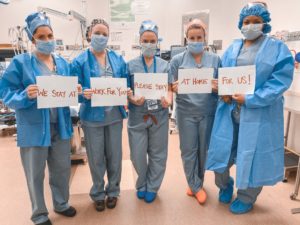The first time I cried during this pandemic was March 17 when I read that in Italy people over 60 years old were being left on gurneys in the hallway to choke on their own sputum. Patients with coronavirus had
exceeded the hospitals’ capacity. I had been watching the news and stories from Italy closely in anticipation of what was going to happen in our country assuming we were just a few weeks behind them in this crisis. I cried then not only for Italy but for myself. I wondered if I was going to be one of those over 60 left to die if our hospitals were also unable to handle the potential number of very sick COVID-19 patients.
The second time I really teared up was when I thought about my daughter who is the Chief Nurse Practitioner (NP) on the inpatient orthopedic/spine service at Brigham and Women’s Faulkner Hospital in the Boston area and reassigned to work shifts in the ICU with COVID-19 patients. I feared the worst for my family. That she would get exposed and transmit it to her husband and five-year-old daughter who both have very bad asthma and are allergic to almost everything. We knew this virus was not just killing elders. People of all ages and especially those with underlying conditions were and are still at high risk.
Most of the times I have had tears since then has been watching a nurse or physician tell their story on the news. Describing what it is like to care for intubated COVID-19 patients, helping their patients’ families understand there is nothing more they can do, and sharing the fears they have for their own families when they go home from their shift. I have also cried when I see the stories of family members dying within days of each other from this virus, many of them people of color who are essential workers who can’t stay home.
I have listened to my own daughter describe the days she was assigned to work an ICU shift with COVID-19 patients. While it was not the overall intensity of what we have seen on the news in New York City hospitals, every individual case she described was just as sad and heartbreaking. And the emotional and physical toll on the nurses, doctors and respiratory therapists was obvious.
On the brighter side of this crisis, I have smiled with joy as healthcare workers in NYC celebrate the 500th or 1000th COVID-19 patient discharged from their hospital.
I have appreciated and respected the order to stay home and flatten the curve – especially liking the pictures we have all seen of healthcare workers with signs that say “we go to work so you can stay home”.
Our healthcare workers, especially our nurses, are on the frontlines of this crisis. They deserve not only our respect and gratitude but our support. What does that mean for you, especially as states start to slowly re-open? Maintain social distance and wear a mask when you go out. And most importantly, they deserve to be protected from this virus with proper and adequate personal protective equipment (PPE).
My first blog post on COVID-19 was on March 16. Since then, I have focused on my piece of the healthcare world – information technology – knowing how critical IT teams and the solutions they provide are to our healthcare workers. As of March 16, there were approximately 4,600 reported cases of coronavirus in this country and 95 people had lost their life to this virus. Now 8 weeks later, over 80,000 people have lost their lives. Nurses, physicians, and other healthcare workers all over the world have risked exposure as they care for COVID-19 patients, often without adequate PPE.
On May 8th, nurses protested in front of the White House – they displayed 88 pairs of white shoes to represent the 88 nurses in the U.S. who have died from coronavirus. A number that has doubled in just two weeks. They were protesting for adequate PPE.
I have written about and celebrated nurses the past few years during National Nurses Week. Little did I know that the title of my 2018 post would be a spot on message for 2020, the Year of the Nurse – Celebrate nurses, but more importantly listen to them.
Let this be the last National Nurses Week ever where instead of simply celebrating and thanking our incredible nurses for what they do every day we have to speak out about what they need to do their jobs safely.
No one can inspire and thank nurses like nursing leaders can. I leave you with inspirational messages from a few of them:
A Message from Maddy Pearson to Brigham Nurses – From the Brigham and Women’s Hospital and Brigham Health Senior Vice President of Clinical Services and Chief Nursing Officer, Maddy Pearson, DNP, RN, NEA-BC
In Times of Crisis, Nurses Run Toward the Unknown – Not Away – From the UnityPoint Health Chief Nursing Executive, Mary Ann Osborn, MA, RN
Caring through Crisis: Innovating in the Moment and Caring through Crisis: Into the Unknown – two podcasts from nursing leaders at University Hospital in Cleveland, OH
With heartfelt thanks and appreciation to all nurses today and every day!
Be well. Be strong. Be smart.

